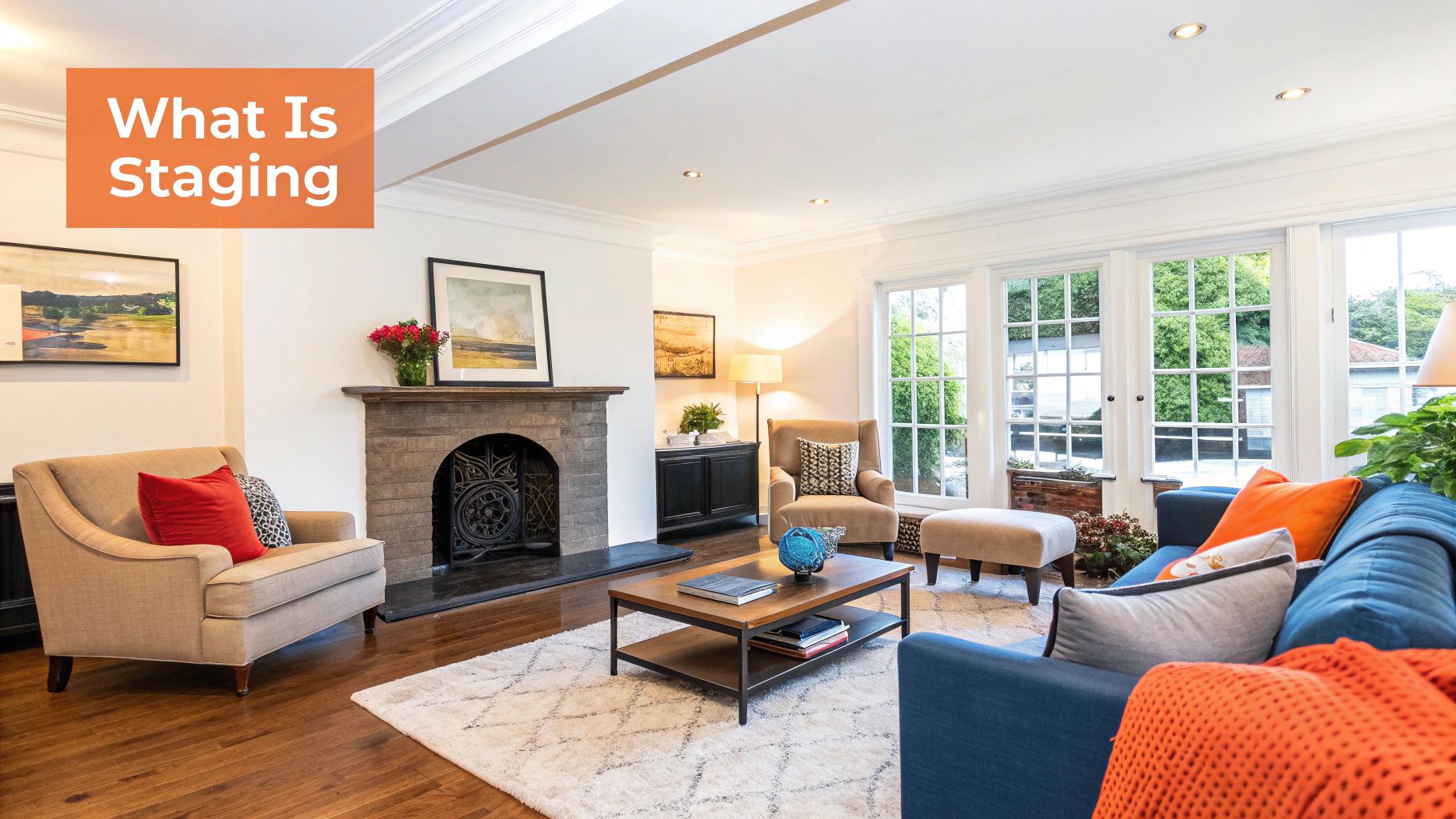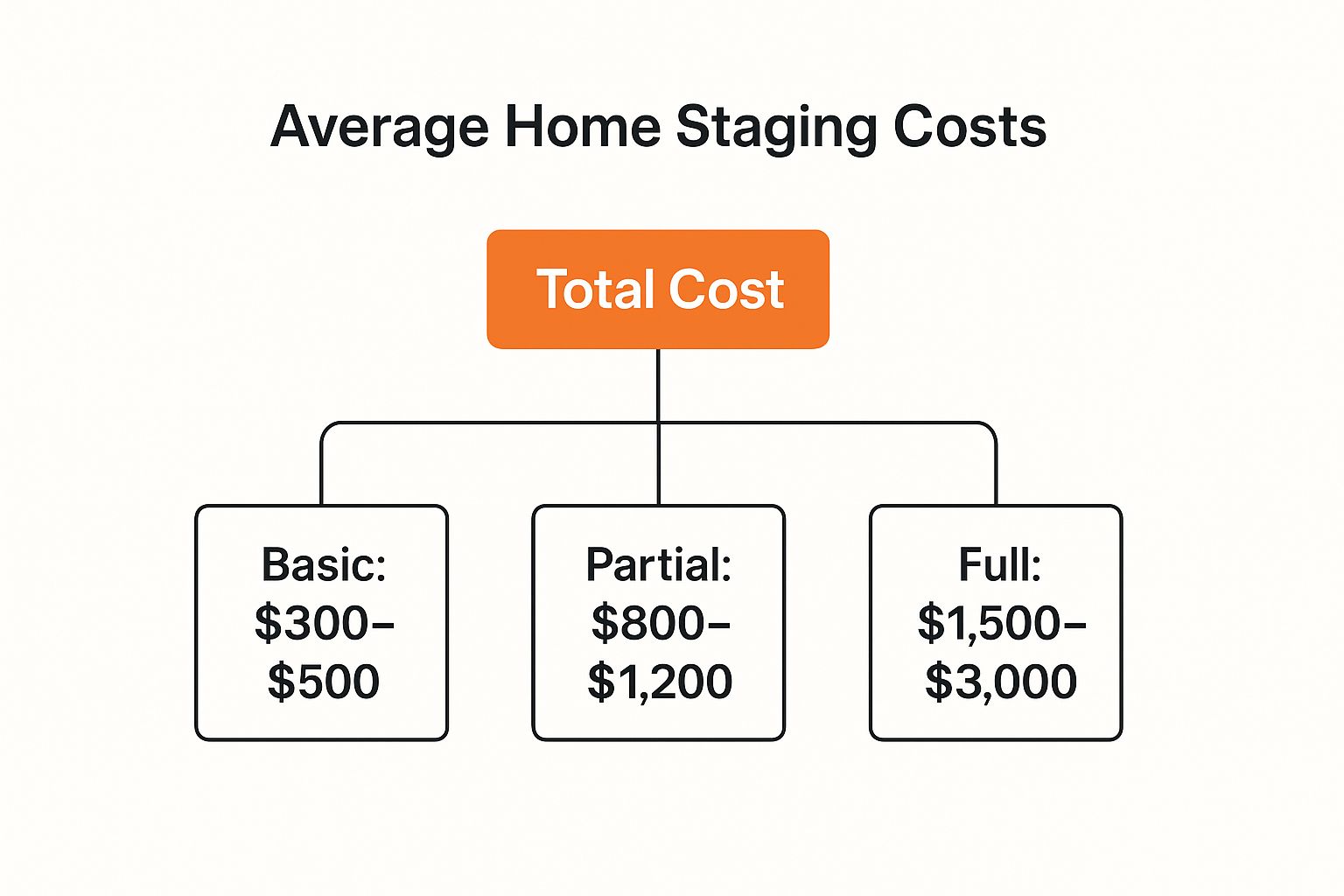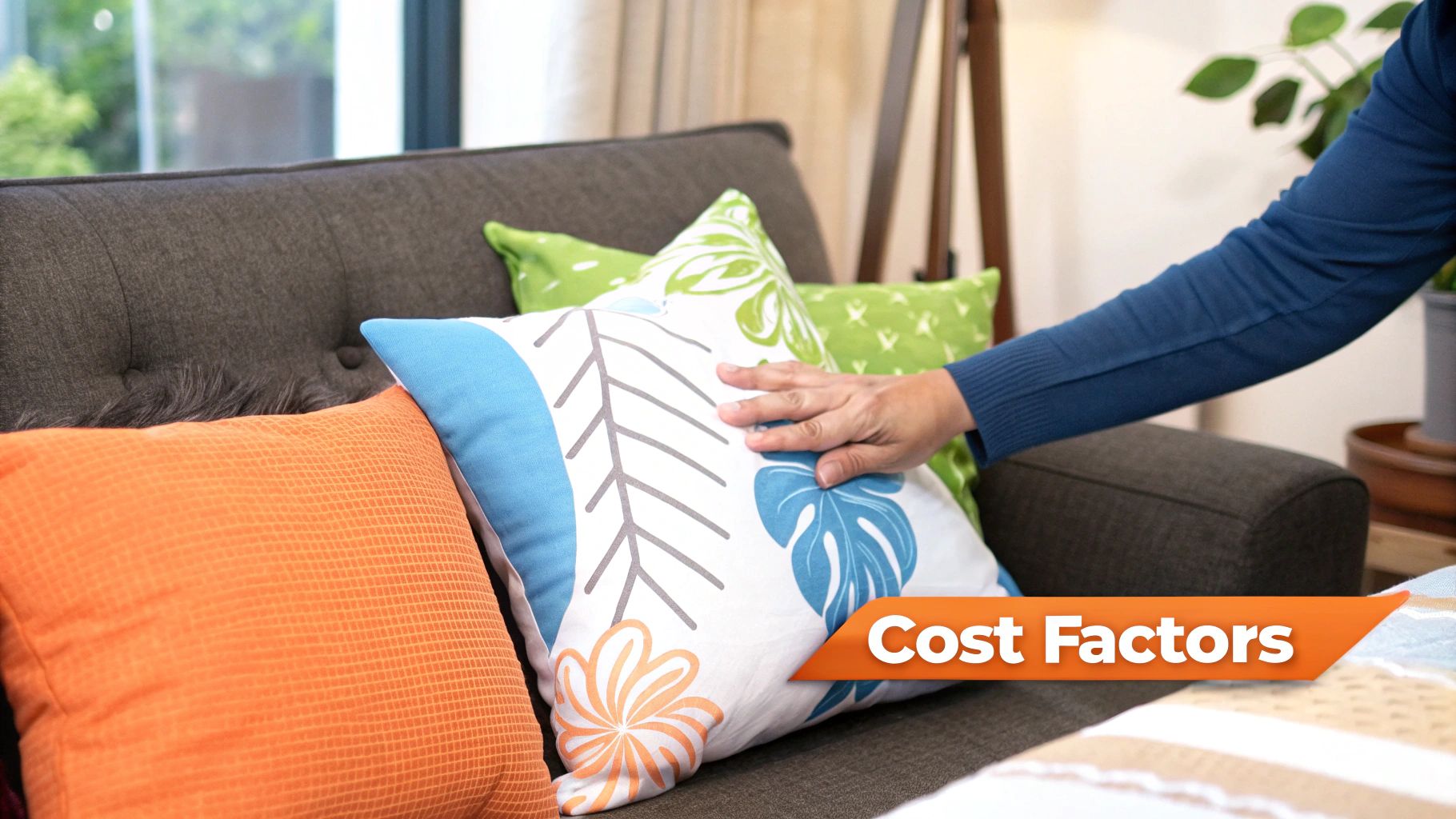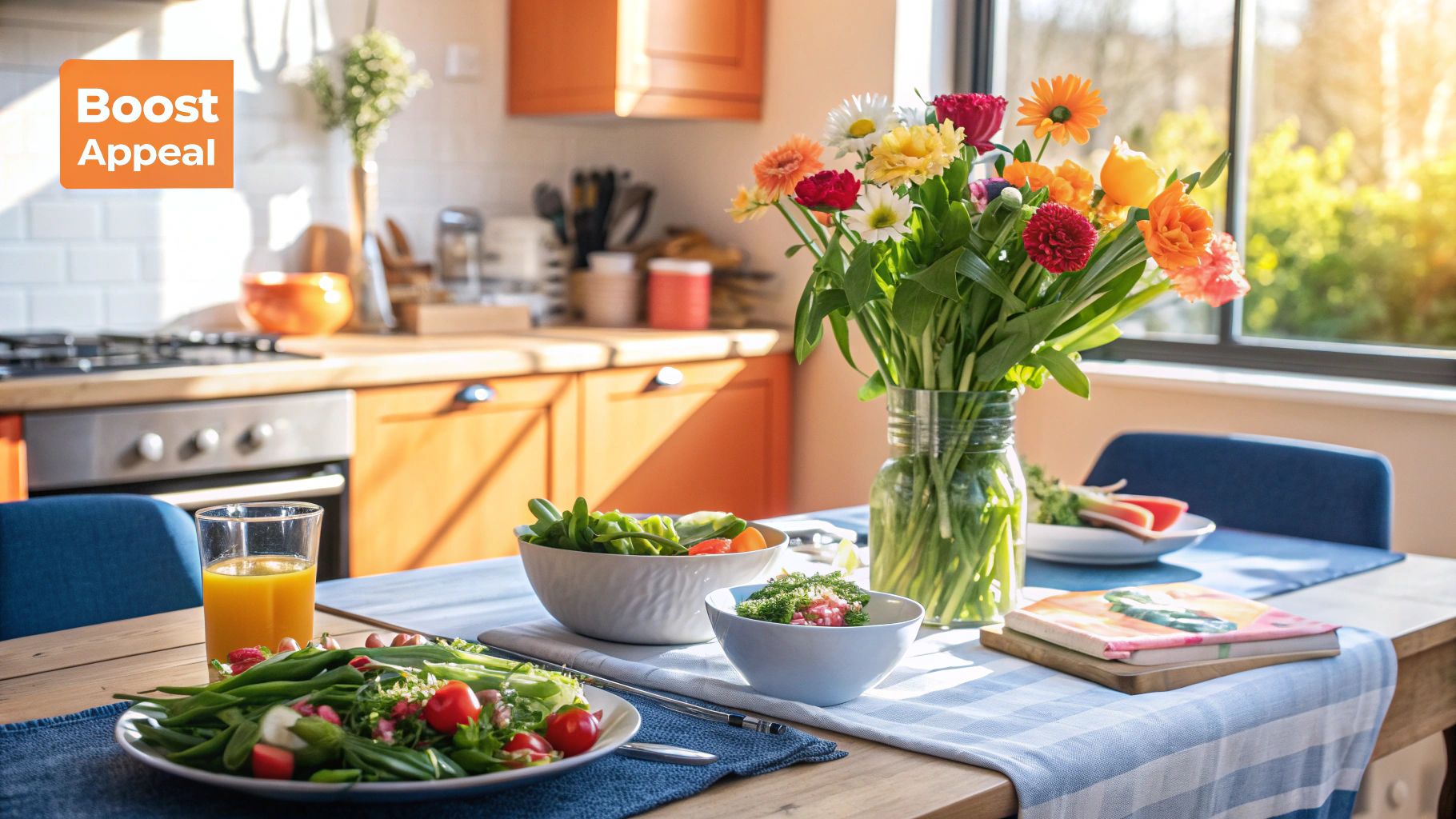The Average Cost of Home Staging Explained
What's the average cost of home staging? This guide breaks down pricing, ROI, and how to budget for staging to sell your home.
So, you’re thinking about home staging and wondering what it’s going to cost. It’s a smart question. The truth is, the price tag can vary quite a bit, but on average, most homeowners find themselves spending between $832 and $2,926. The national sweet spot lands right around $1,843.
It’s tempting to see that number as just another expense in the long list of selling costs. But I always tell my clients to think of it differently. Staging isn’t a cost; it’s an investment in creating an unforgettable first impression that helps buyers emotionally connect with your house.
What Is the Real Cost of Home Staging?

Image
Drilling down into the “real” cost of staging is a bit like pricing out a new car. You have the base model, but then there are all the upgrades and premium packages. The final price tag depends entirely on what you choose. Home staging works the same way; it’s not a one-size-fits-all service. The cost is tailored to your specific property and its needs.
The biggest factor that will swing the price one way or the other is whether you’re living in the home or if it’s sitting empty. Staging a vacant home is almost always more expensive. Why? Because you’re essentially renting an entire house full of furniture, from the big pieces like sofas and beds down to the last decorative pillow and piece of wall art.
If you’re still living in the house, a stager can get creative and work with what you already own. They’ll often rearrange your furniture and bring in select rental pieces to fill in the gaps and give your home that polished, “model home” feel.
Breaking Down the National Average
Let’s get back to the numbers. While the national average to professionally stage a home is $1,843, most people will land somewhere in the $832 to $2,926 range. The difference really comes alive when you compare an occupied home to a vacant one. Staging an occupied home might cost around $800, but a vacant property can easily jump to $2,000 or more because of all the furniture and decor rentals involved. For a deep dive into industry data, professional service reports offer great insights on home staging costs.
A professional stager’s initial consultation is the first step and typically costs between $150 and $600. This is where they assess your home and develop a tailored plan to highlight its best features.
This initial meeting is incredibly valuable. A stager will walk through your home with a buyer’s eye and create a roadmap for making it look its absolute best. Even if you decide to do some of the work yourself, that expert guidance can be a game-changer. For more DIY-friendly ideas, check out our guide on effective home staging tips.
Home Staging Cost at a Glance
To give you a clearer idea of the potential costs, I’ve put together a quick summary. This table breaks down the typical price ranges for different staging scenarios, helping you see where your project might fall.
| Staging Scenario | Average Cost Range |
|---|---|
| Initial Consultation | $150 – $600 |
| Occupied Home Staging | $600 – $1,200 |
| Vacant Home Staging | $2,000 – $7,000+ |
| Monthly Furniture Rental | $500 – $2,000 per month |
As you can see, the scope of the project is what really drives the cost. A simple consultation is an affordable way to get started, while fully staging a large, empty home will naturally be at the higher end of the investment scale.
What Drives Home Staging Prices?
So, why does one homeowner get a staging bill for $800 while their neighbor pays closer to $3,000? The truth is, there’s no single price tag for home staging. The final cost is a blend of several key factors, and understanding them is the first step to setting a realistic budget.
Think of it like planning a party. The final bill isn’t just a flat fee; it depends on how many people you invite, what you serve, and how long the party lasts. Home staging works the same way—the price is tailored to what your specific property needs to shine.
Home Size and the Scope of the Job
The biggest and most obvious factor is the sheer size of your house. It just makes sense: staging a sprawling 3,500-square-foot, five-bedroom home is a much bigger job than a cozy 900-square-foot, one-bedroom condo. More space means more furniture, more accessories, and more time for the stager to get everything just right.
But it’s not just about square footage. It’s also about which rooms you decide to stage. Most stagers will tell you to focus your budget on the rooms that pack the biggest emotional punch for buyers. These are the spaces where people imagine their lives unfolding.
- The Living Room
- The Kitchen
- The Primary Bedroom
- The Dining Room
Sticking to these key areas gives you the most bang for your buck, creating a powerful first impression without breaking the bank. A full-home staging is usually reserved for vacant, high-end properties where every single room needs to be built from the ground up.
Is the Home Vacant or Occupied?
This is a huge fork in the road for pricing. Staging a vacant home is a much bigger lift because the stager is walking into an empty shell. They have to bring in everything—from the sofa and dining table right down to the hand towels and coffee table books.
On the other hand, an occupied home already has the basics. A good stager can work with what you’ve got, rearranging furniture to create better flow and then bringing in a few strategic rental pieces to elevate the look. This is almost always the more budget-friendly route.
The bottom line: A vacant home costs more because you’re renting a full house of furniture. An occupied home leverages your existing pieces, which keeps rental costs down.
This image breaks down how these different levels of service typically stack up in terms of cost.

As you can see, the price climbs directly with the amount of work and furniture involved, from a simple consultation to a full vacant staging.
Rental Time and Where You Live
Finally, two more things come into play: time and location. Most staging contracts will include the furniture rental for a set period, usually 30 to 90 days. If your home flies off the market in a week, fantastic! But if it lingers, you’ll likely have to pay a monthly renewal fee to keep the furniture, which can run anywhere from $500 to $2,000.
And, of course, where you live matters. Staging in a competitive, high-cost-of-living city is naturally going to be pricier than in a small town. Even the specific decor choices, like the chandelier size and its impact on staging costs, can nudge the final price up or down.
Is Staging Really Worth the Money? Calculating Your Return on Investment

Alright, you’ve seen the numbers behind staging costs. Now comes the million-dollar question: is it actually worth it? The answer is a resounding yes, but only if you shift your mindset. Stop thinking of staging as just another expense and start seeing it for what it is—a strategic investment in your final sale price.
This is where the concept of Return on Investment (ROI) comes in. It’s pretty simple. If you put $2,000 into professional staging and that helps your home sell for $10,000 more than it would have otherwise, you haven’t just broken even. You’ve made an $8,000 profit on your decision to stage. The data shows this isn’t just wishful thinking; it’s a consistently proven outcome.
Staging by the Numbers
Let’s be clear: the statistics behind home staging are compelling. A beautifully staged home doesn’t just look nice; it creates an emotional pull that makes buyers act faster and bid higher. In fact, research shows that professionally staged properties can sell for anywhere from 5% to 23% over the list price. That’s a serious bump. On a $400,000 home, a modest 5% increase puts an extra $20,000 in your pocket.
Real estate agents see this happen every day. According to one study, 22% of sellers’ agents reported a 1% to 5% jump in the final sale price that was directly tied to staging. If you want to dive deeper into the data, you can review home staging statistics and see the financial impact for yourself.
It all boils down to a simple principle: investing in how your property is presented pays off. Staging isn’t just about making a house look pretty—it’s a powerful marketing tool that shapes buyer perception and directly boosts your bottom line.
A Tangible Scenario
Let’s walk through a real-world example to make this crystal clear.
Imagine you’re selling your home, listed at $500,000. After some thought, you decide to invest $2,500 in professional staging, targeting the high-impact areas: the living room, kitchen, and primary bedroom.
Suddenly, your online listing photos are stunning. They grab attention, and your agent is booking back-to-back showings. A buyer walks in, falls in love with the move-in-ready vibe, and makes an offer for $515,000—a 3% increase over your asking price.
Here’s how the math shakes out:
- Sale Price Increase: $15,000
- Staging Cost: $2,500
- Net Profit from Staging: $12,500
In this very common scenario, your initial investment didn’t just pay for itself; it generated a huge profit. Staging is what turns your property from just another listing into a product people desperately want. And if you’re curious about other ways to get the most out of your sale, our guide on how to increase your home’s value has plenty of other great tips. Ultimately, that modest upfront cost for staging can be one of the smartest financial moves you make.
Choosing the Right Type of Staging Service
Home staging isn’t a one-size-fits-all deal. The right approach really comes down to your property’s specific needs, your budget, and how much elbow grease you’re willing to put in yourself. Think of it like deciding on dinner: you could grab a quick slice of pizza, sit down for a three-course meal, or go all out with a chef’s tasting menu. Each one gets the job done, but they serve different appetites and have very different price tags.
Before you can figure out what staging will cost, you need to know what’s on the menu. Picking the right service is the key to making your investment count and getting the best possible return when you sell.
The Staging Consultation
If you’re on a tight budget or just need a professional game plan you can execute yourself, the staging consultation is your best starting point. It’s the simplest and most affordable option. A professional stager will walk through your home with you, room by room, and give you a detailed action plan.
This report is basically your expert-guided DIY checklist. It’ll tell you:
- What to pack up: How to declutter and remove personal items so buyers can see themselves there.
- How to arrange furniture: Ways to improve the flow and show off your home’s best features.
- Simple, high-impact updates: Suggestions for paint colors or minor fixes that pack a punch.
- Finishing touches: Tips on where to place decor and accessories to create that “wow” moment.
A consultation typically runs between $150 and $600. It’s a small price to pay for a professional blueprint that empowers you to get your home market-ready.
Partial Staging for Occupied Homes
What if your home is already furnished but just needs that extra bit of polish? That’s where partial staging comes in. This is a great choice if you’ll be living in the house while it’s for sale.
The stager works with what you already have, rearranging your best pieces and then supplementing them with carefully chosen rentals. This could mean bringing in a modern area rug, some new artwork, fresh bedding, or a few stylish accessories to tie everything together. It’s a smart, collaborative approach that elevates your home’s look without the cost of furnishing it from top to bottom.
Full Staging for Vacant Homes
For an empty house, full staging is the whole nine yards. A stager furnishes the most important rooms from scratch, turning a cold, empty space into a place that feels like a home. This involves renting all the furniture, rugs, art, lighting, and decor needed to create an inviting atmosphere.
Because it requires a full inventory of rented furnishings, full staging is the biggest investment. But for a vacant property, it’s also the most effective way to help buyers make an emotional connection and truly see the home’s potential.
The Rise of Virtual Staging
There’s also a powerful and budget-friendly alternative that’s become incredibly popular: virtual staging. Instead of moving physical furniture, designers use specialized software to digitally add stylish decor and furnishings to photos of your empty rooms.
Since 95% of buyers start their home search online, this is a fantastic way to make your listing pop. It helps you showcase what a property could look like, attracting more interest and getting more buyers through the door. For a deeper look, you can explore the benefits of virtual home staging services to see how it works. It costs just a fraction of traditional staging, making it a brilliant tool for boosting your online presence.
How to Budget and Save on Home Staging

Knowing the average cost of home staging is the first step, but figuring out how to make it work for your specific budget is where the real strategy comes in. The great news is you don’t need to break the bank to see fantastic results. With a smart approach, you can achieve that polished, buyer-friendly look without overspending.
Think of your staging budget as a spotlight. You aren’t trying to light up the entire stage at once; you’re focusing the beam on the areas that will make the biggest impression. For your home, this means putting your money where it matters most to buyers.
Prioritize High-Impact Rooms
In the eyes of a potential buyer, not all rooms carry the same weight. Time and again, we see that certain spaces have a much bigger pull on their final decision. If you concentrate your budget on these key areas, you’ll ensure every dollar you spend is working its hardest.
The rooms that consistently deliver the biggest bang for your buck are:
- The Living Room: This is where buyers picture themselves relaxing and hosting guests.
- The Kitchen: Often called the heart of the home, this space needs to shine.
- The Primary Bedroom: This room should feel like a personal, peaceful sanctuary.
Nailing the look in these three spots creates a powerful first impression that sticks with people. If you still have room in the budget, the dining room is a great next choice.
Blend DIY Efforts with Professional Help
One of the best ways to manage costs is to tackle the straightforward prep work yourself and bring in a pro for their design expertise. This hybrid model saves a ton on labor costs while still giving you the benefit of a professional’s touch.
Staging isn’t just about what you add—it’s also about what you take away. Decluttering and depersonalizing are two of the most powerful things you can do, and they cost nothing but a bit of your time.
As you start clearing out your home, you’ll likely need a place to stash extra furniture and personal belongings. It’s a smart move to explore self-storage options early in the process so you have a plan for where everything will go.
Here are a few tasks you can easily handle on your own:
- Decluttering: Box up family photos, memorabilia, and any extra decor.
- Deep Cleaning: Make every single surface sparkle, from the windows to the baseboards.
- Minor Repairs: Touch up scuffed paint, fix that leaky faucet, or patch small nail holes.
Once you’ve prepped the canvas, a professional stager can work their magic, arranging furniture and decor to make the home look its absolute best.
Shop Around and Negotiate Terms
Finally, never go with the first quote you get. Just like any other service for your home, it pays to get proposals from at least three different staging companies. This lets you compare not only the bottom-line price but also what’s included and whether their style fits your home.
Don’t forget to ask about the rental terms. Most staging contracts lock you in for 30 to 90 days of furniture rental. If you’re in a hot market and expect a quick sale, ask if they offer a shorter-term contract at a better price. You’d be surprised how often a simple conversation can lead to a solution that works perfectly for your budget.
Common Questions About Staging Costs
https://www.youtube.com/embed/J1cNiGyM9uk
Even with all the numbers broken down, it’s completely normal to have a few more questions pop up. The average cost is one thing, but understanding the practical side of things—like when you pay and what happens with all that furniture—is what really helps you feel confident moving forward.
Let’s walk through some of the most common things homeowners ask. This is your go-to guide for the nitty-gritty financial and logistical details, so there are no surprises down the road.
Do I Pay for Staging Upfront or at Closing?
This is easily one of the most popular questions, and the answer is pretty straightforward: you almost always pay for staging services upfront.
Think of professional stagers like any other contractor or service professional you’d hire for your home. They require payment before the work gets underway. You’ll typically pay the consultation fee on the day of the meeting, and the full staging fee is due before they bring in a single piece of furniture.
While a few real estate agents or staging companies might offer programs that let you defer payment until your house sells, that’s the exception, not the rule. It’s safest to plan for staging as an initial investment you’ll need to cover before your home officially goes on the market.
How Long Does Rental Furniture Stay in the Home?
Most staging contracts are designed to last for a set period, giving your home plenty of time to attract buyers.
A standard staging agreement typically includes furniture rental for an initial term of 30 to 90 days. This is all baked into the initial price you pay.
If your home gets snapped up quickly, the stager will simply schedule a time to de-stage and remove everything before closing. But what if your home is still listed after that initial period? You’ll need to pay a monthly renewal fee to keep the staged look. This fee can run anywhere from $500 to over $2,000 per month, depending on how much furniture is in the home.
Can I Use My Own Furniture to Save Money?
Absolutely! This is a great way to cut down on costs, and it’s exactly what stagers do in an “occupied” or “partial” staging. A good stager is an expert at working with what you already own. They’ll rearrange your furniture to create better flow and then supplement it with a few key rental pieces to tie the whole look together.
That said, a stager will also give you their honest, professional opinion on which of your items might be holding the space back. They may suggest moving that oversized sofa, a dated armchair, or a well-loved but worn-out table into storage. Using your own furniture is a fantastic budget-saver, but the magic happens when you trust your stager’s advice on what to feature and what to hide.
Ready to create stunning, buyer-enticing visuals without the high cost and hassle of physical staging? With Pedra, you can virtually stage, declutter, and enhance your property photos in a single click. Transform empty rooms into dream homes and sell properties faster. Explore the future of real estate marketing at https://pedra.so.

Related Posts
3D Photography for Real Estate Guide
Explore our guide to 3D photography for real estate. Learn how immersive virtual tours can attract q...
Effective Copywriting for Real Estate to Sell Homes Fast
Discover expert copywriting for real estate that boosts property sales. Learn tips to craft compelli...
Top Floor Plan Creator Software of 2025 | Design with Ease
Explore the best floor plan creator software of 2025. Find intuitive tools and powerful features to ...